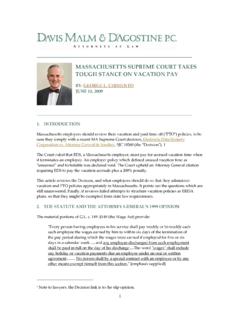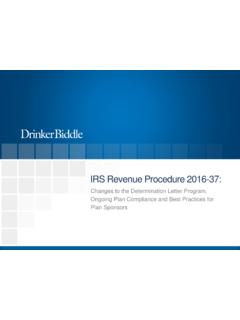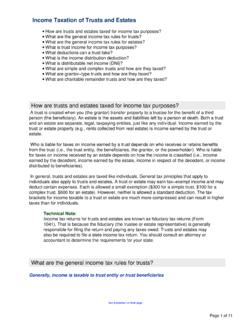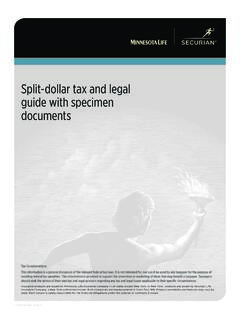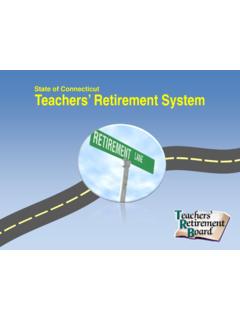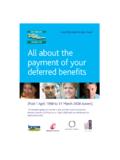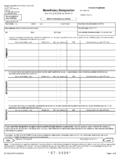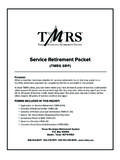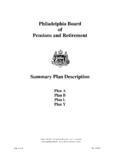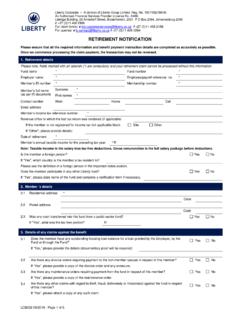Transcription of MAKING RETIREMENT BENEFITS PAYABLE TO TRU STS
1 4/4/13 MAKING RETIREMENT BENEFITS PAYABLE TO TRUSTSBy: Natalie B. Choate, , McClennen, & Fish/Boston MAThis seminar handout is an expanded version (it contains more examples and discussion) of Chapter 6, plusselected other sections and forms, from the author s book Life and Death Planning for RETIREMENT BENEFITS ,7 ed. 2011 ( ; see Appendix C). Copyright 2013 by Natalie B. Choate. All rights Trust as Beneficiary: Trust as beneficiary: Drafting Trust accounting for RETIREMENT Trust accounting: Drafting Total return or unitrust Transferring a RETIREMENT plan out of a trust or Can a participant transfer an IRA to a living trust?.. Individual RETIREMENT trusts (trusteed IRAs).. Prohibited transaction The Minimum Distribution Trust The minimum distribution rules: Executive When and why see-through trust status MRD trust rules: Ground What a see-through trust is; the five trust rules.
2 Dates for testing trust s compliance with Rule 1: Trust must be valid under state Rule 2: Trust must be Rule 3: Beneficiaries must be Rule 4: Documentation Rule 5: All beneficiaries must be Payments to estate for expenses, Effect of 645 election on see-through MRD Rules: Which Trust Beneficiaries Count?.. If BENEFITS are allocated to a particular share of the Separate accounts: BENEFITS PAYABLE to a trust or Beneficiaries removed by Beneficiary Finalization Disregarding mere potential successors .. Conduit trust for one Conduit trust for multiple Accumulation trusts: Accumulation trust: Accumulation trust: Circle Accumulation trust: 100 percent grantor Powers of Combining two types of qualifying Estate Planning with the MRD Trust Boilerplate provisions for trusts named as Advance rulings on see-through trust Should you use a separate trust for RETIREMENT BENEFITS ?
3 Planning choices: Trust for disabled Planning choices: Trusts for Planning choices: Trust for Generation-skipping and perpetual Younger heirs at law as wipeout How to Analyze (and Clean Up) a See-Through Trust Income Taxes: DNI Meets Income tax on RETIREMENT BENEFITS paid to a Trust passes out taxable income as part of DNI .. Trust must authorize the Trusts and the IRD IRD and the separate share IRD, separate shares, and discretionary Income tax effect of transferring Funding pecuniary bequest with right-to-receive See-Through Trust Tester A: Selected Sections from Other Chapters of Life and Death Planning for RETIREMENT When is a trust for the spouse the same as the spouse?
4 Tax on transfer of the right-to-receive Leaving RETIREMENT BENEFITS to a QTIP IRS regards BENEFITS , trust, as separate items of Entitled to all income: State law vs. Do not require stub income to be paid to spouse s estate!.. Combination marital deduction-conduit B: Selected C: Used in this Handout Refers to a section of the Code unless otherwise indicated. Refers to a section of the author s book Life and Death Planning for RETIREMENT BENEFITS (7thed., 2011; see Appendix C). If the section number begins with 6., it can be foundelsewhere in this handout. If the reference does not begin with 6. , but mentionsAppendix A, it can be found in Appendix A of this handout.
5 Otherwise it refers to a sectionof the book not reproduced Distribution Period. Finalization Date. Revenue Code of 1986 as amended through March net income. RETIREMENT Account. in respect of a decedent. See , Appendix Revenue RETIREMENT trust (trusteed IRA). Required Distribution. to now-living person. private letter RETIREMENT Plan. 401(a).RBDR equired Beginning Date. Trust as Beneficiary: PreliminariesThis provides, first, a checklist for drafting a trust to be named as beneficiary of aretirement plan. The rest of covers how trust accounting rules apply to RETIREMENT benefitspayable to a trust as beneficiary; the transfer of RETIREMENT benefit accounts into and out of trusts; andthe individual RETIREMENT trust (or trusteed IRA or IRT ).
6 Trust as beneficiary: Drafting checklistWhen the estate plan calls for naming a trust as beneficiary of RETIREMENT BENEFITS , use thischecklist to review planning and drafting considerations uniquely applicable to such there a strong estate planning reason to name a trust as beneficiary, or is there a way toachieve the planning goals without incurring the risks and complications of naming a trust?In view of the complications and other disadvantages involved in MAKING RETIREMENT benefitspayable to a trust, the bias is in favor of leaving the BENEFITS outright to the intended beneficiariesunless there is a compelling reason to leave them in trust. The rest of this checklist deals withdrafting the trust, once it has been decided to name a trust as the trust contains special provisions dealing with RETIREMENT BENEFITS , be sure you define RETIREMENT BENEFITS .
7 The dispositive terms so they will operate on the RETIREMENT BENEFITS in accordance withthe donor s intent. For example: If the trust s dispositive terms will distinguish between income and principal consider how these terms will apply to the RETIREMENT plan and todistributions from it. See If a beneficiary is given the annual right to withdraw fivepercent of the trust principal, will the withdrawal power apply to the gross value of anyretirement benefit that is PAYABLE to the trust (with or without a reduction for the built-inincome tax debt )? Or will it apply only to amounts the trustee has actually withdrawn fromthe RETIREMENT plan? the trust is intended to qualify for the federal estate tax marital deduction, comply with therequirements described in (D) below and in [see Appendix A].
8 Whether see-through trust status is important ( ), and, if it is important,make sure the trust complies with IRS s MRD trust rules. Precatory languageurging the trustee to take steps to achieve the stretch payout is not enough; see PLR 2010-21038 (discussed at of Life and Death Planning for RETIREMENT BENEFITS ). The trustshould be drafted so that it qualifies as a see-through trust without the necessity of any trustamendments or reformations after the client s the trust is to be divided into multiple shares or subtrusts for the benefit of differentbeneficiaries upon the client s death, see regarding whether, if RETIREMENT benefitsare allocated only to one particular share, beneficiaries of the other shares are disregarded forMRD purposes, and regarding how the separate accounts rule applies to trusts.
9 Ifthe BENEFITS are to pass to multiple beneficiaries, and separate accounts treatment isimportant, leave the BENEFITS to the various beneficiaries directly ( , do not leave thebenefits to a trust to be divided among the multiple beneficiaries) in the beneficiarydesignation form. See Form , Appendix B. For the same reason, if leaving BENEFITS to atrust for the participant s surviving spouse, and the trust is to pass outright to the participant sissue on the death of the surviving spouse, name the trust as beneficiary only if theparticipant s spouse survives the participant; name the issue directly as contingentbeneficiaries if the spouse does not survive.
10 See and Form , Appendix avoid the issue of whether funding a pecuniary bequest with the right to receive IRD is a taxable transfer ( ), avoid having RETIREMENT BENEFITS pass through a pecuniaryfunding formula. If BENEFITS must pass to a trust, make them PAYABLE to a trust that will notbe divided up. If BENEFITS are going to a trust that will be divided, either specify clearly (inboth the beneficiary designation form and the trust instrument) which trust share theseretirement BENEFITS go to (so that the BENEFITS pass to the chosen share directly, rather thanthrough the funding formula), or use a fractional formula (fulfillment of which does nottrigger immediate realization of IRD) rather than a pecuniary formula (which may).
